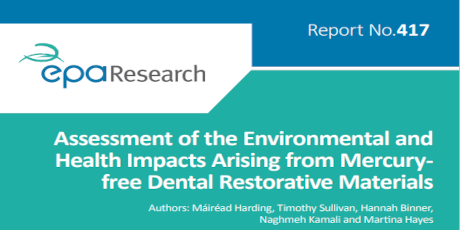Getting our teeth into the environmental impacts of mercury-free fillings 05 Aug 2022

The EPA has just published the EPA Research Report 417: Assessment of the Environmental and Health Impacts Arising from Mercury-free Dental Restorative Materials led by a collaborative team from the ERI and the Cork University Hospital Dental School’s Oral Health Services Research Centre (OHSRC)
Why was this research carried out?
The United Nations Minamata Convention on Mercury aims to protect human health and the global environment from the harmful effects of mercury. The Convention addresses the use of mercury-containing dental restorative materials (fillings) and their phaseout in dental practice.
Controls present in dental practices have minimised the environmental impacts of mercury-containing dental filling materials. However, less is known about the newer mercury-free dental restorative materials and their environmental impact.
This project was designed to assess potential environmental and health impacts arising from mercury-free dental restorative materials.
Watch the Project Highlights Video
What does it tell us?
- Particles from the filling materials were present in dental wastewater streams, the largest being 1.2 to 5 µm2 in size, suggesting the presence of many small particles in DWW. Amalgam separators, types 1 and 2, used in this study did not retain the small particle constituents from mercury-free dental restorative materials.
- Ecotoxicity testing of dental wastewater from participating dental practices with the planktonic crustacean Daphnia magna demonstrated a deleterious effect on the crustacean. More extensive ecotoxicity testing is recommended..
How might the research be used?
Given the move away from mercury-containing dental filling materials, it will be essential to consider enhanced capture of small particles from dental wastewater. The research highlights that appropriate maintenance and use of amalgam separators and all engineering controls should be emphasised and guidance should also include taking precautions to minimise dust aerosolization;
The research highlights that further work with respect to the chemical components of mercury-free dental filling materials should be conducted to comprehend both the inorganic and organic components of mercury-free dental restorative materials and their environmental impacts.
Given the challenges and absence of evidence with respect to dental restorative filling materials, the research advises that an emphasis on health promotion, prevention and expansion of primary oral healthcare services for the public for all ages should be embraced as part of the solution.
Link to the Report:
EPA Research 417: https://www.epa.ie/publications/research/environment--health/research-417.php
Authors:
Máiréad Harding, Timothy Sullivan (ERI), Hannah Binner (ERI), Naghmeh Kamali and Martina Haye